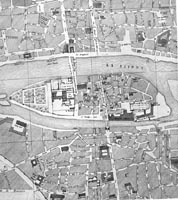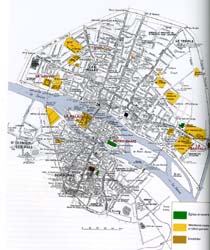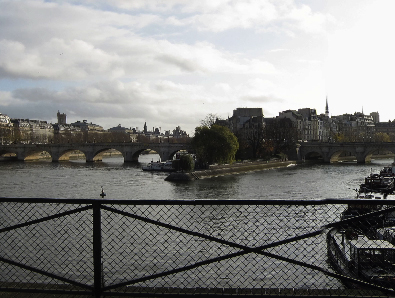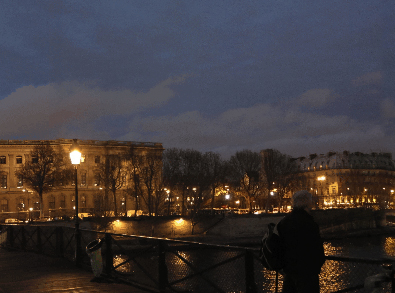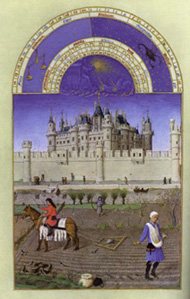Art Web | Arth
Home | Arth Courses | Arth 110 |ARTH 110 Assignments |
Forward | Back | Contact
ARTH 110
FRENCH COURT ART: THE LIMBOURG BROTHERS
SLIDE LIST 2

|
|

|
| The Limbourg Brothers, Annunciation to the Virgin, from
the Très riches
heures of Jean de Berry, c. 1413-16. | Mary of Burgundy at her devotions from the Hours of
Mary of Burgundy, before 1482. See web-page. |

|
 
|
| The Limbourg Brothers, October from the
Très riches heures. |
St. Denis commissioning his biography.
from the Life of St. Denis, given to King Philip V in 1317. |
|

|
| Views of the Seine from same spot on the bridge in front
of the Institut de France. The Institut occupies the site of Jean de Berry's
city house of Nesle. |
Limbourg Brothers, June from the Très
riches heures. |

Model of the 14th century Louvre with foundations in the background.
|
|
|
| Image roughly superimposing the Limbourg's image of the medieval Louvre
onto a photograph of the modern Louvre. |
Image roughly superimposing the Limbourg image of the Ile
de la Cité onto a photograph of the same view. |

|

|
| Limbourg Brothers, January from the Très
riches heures. |
Limbourg Brothers, February from the Très
riches heures. |

|
|
| Limbourg Brothers, March from the Très
riches heures. |
Limbourg Brothers, Zodiac Man from
the Très riches heures. |

|

|
| Limbourg Brothers, April from the Très
riches heures. |
Limbourg Brothers, May from the Très
riches heures. |
TERMS
Illuminated manuscript- a handwritten book decorated with illustrations
(miniatures) and/or decorated initials and border decoration.
Book of Hours; a devotional book intended for private prayer
that became popular in fourteenth and fifteenth Europe. The primary
devotions are dedicated to the Virgin Mary the Mother of Christ.
These books were particularly popular among the aristocracy.
Hierarchic scaling- when certain figures are presented
as larger in scale than others because of their importance within
a social or religious hierarchy.
Quotation
The following quotation from A.J Gurevich's book Categories of Medieval Culture provide us a useful critical perspective to evaluate this culture's conception of labor and property:
The world-view of any society will include that society's concepts of property, wealth, and labour. These are not only politico-economic categories but also moral and ideological ones; labour and wealth may be highly valued or despised, their role in human affairs can be variously assessed. Economic activity is a component of social practice, of the interaction between man and his environment. It reflects the vital preoccupations of a society, and if we are to penetrate the mental climate of this society it is particularly important for us to try to understand its attitudes to labour and property.
LINKS
There are two very useful sites for the
Très riches heures: one is from the University
of Chicago presents high quality scans of the calendar images.
The other presents a more extensive coverage of the complete
manuscript.
For my Northern Renaissance Art course, I have developed
a page discussing the symbolism of the image of Mary
of Burgundy in Prayer. There are also pages I have developed expanding
on our discussion of the Life of St Denis manuscript and the nature of the Late
Medieval Craftsman. For my ARTH 200 course I have developed a page
introducing a discussion about the early calendar miniatures from the Très
riches heures. See also my discussion about the January
page.
MAP
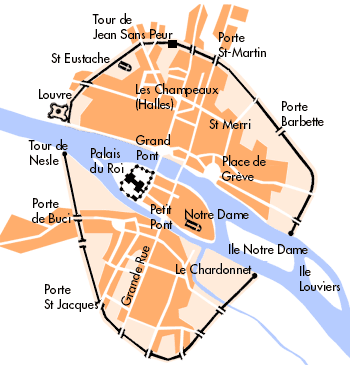
The accompanying map
of medieval Paris is useful to compare to the miniatures of
the Life of St. Denis and the June and October pages from
the Très riches heures. The bridges depicted at
the bottom of the Life of St. Denis miniature show the
Petit Pont and the Grand Pont, the bridges that connected the
Île de la Cité to the two banks of the Seine river.
Both the October and June miniatures are views from the Paris
residence of Jean de Berry adjacent to the "Tour de Nesle."
The June
page is looking northeast towards the western tip of the îLe
de la Cité where can be seen the French royal palace, while
the October
page looks north across the Seine to the Louvre which was the
primary residence of Charles V and Charles VI in Paris. Charles
V housed his famous library in one of the towers.
QTVR VIEWS FROM THE PONT DES ARTS
QUESTIONS FOR REVIEW
| The Limbourg Brothers, October from theTrès
riches heures, c. 1413-16. |
St. Denis commissioning his biographt from
the Life of St. Denis, given to King Philip V in 1317. |
Compare and contrast these two pages. Define
the dramatic stylistic changes that have occurred in French manuscript
painting over the hundred years separating these works. Note important
points of continuity in the patronage of these works.
Calendar of the Très
riches heures:

|

|

|
|
January |
February |
March |

|

|

|
|
April |
May |
June |

|

|

|
|
July |
August |
September |

|

|

|
|
October |
November (miniature by Jean Columbe) |
December |
Art Web | Arth
Home | Arth Courses | Arth 110 |ARTH 110 Assignments
| Forward |
Back | Contact









